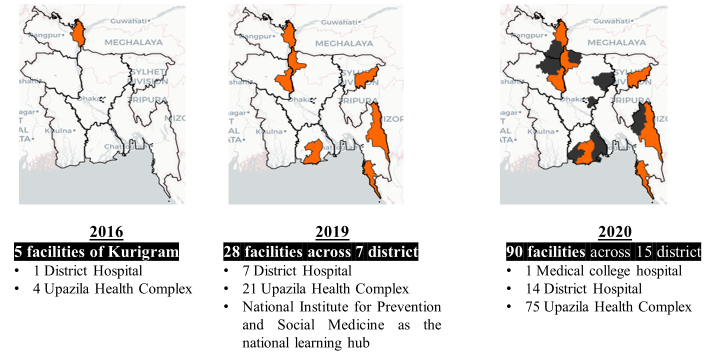Updated Nov 2021
Bangladesh has been implementing QI for maternal and newborn care in about 55 hospitals in 17 districts with support from partner agencies over the last two years. The Ministry of Health is leading the effort. They have organized a series of QI training workshops and are providing onsite support to the QI teams in the hospitals in these districts. The details of quality improvement projects in the districts is provided below.
Over the last two years, the “Kurigram district model” quality improvement programme has shown encouraging results in improving the quality of care in 28 learning facilities across 7 districts. The effort saw nearly 1000 healthcare providers trained to use quality improvement methods. These training sessions were followed up by 350 on-site support visits to build quality improvement skills hands-on. Teams of healthcare providers have carried out more than 200 quality improvement projects. These projects were mainly focussed on care around birth and care of small and sick newborns.
Figure 1: Scaling up quality improvement efforts over time

UNICEF is a lead partner in providing technical support to the Ministry of Health and Family Welfare (MOH&FW) to build institutional capacity to set up and manage a quality improvement system at national and sub-national levels. Since 2019, UNICEF has scaled up its efforts and further partnered to build institutional hubs for quality improvement learning at the national and sub-national level.
The National Institute of Preventive and Social Medicine (NIPSOM) is currently developing its skills and strengthening its systems to support QI efforts in the country. They are developing “QI coaches” who can provide hands-on support to facilities in using QI methods, building systems to disseminate lessons on successes and failure related to efforts to improve quality of care (QoC), and building capacity to manage QoC data. NIPSOM envisions to serve as a national resource in Bangladesh to plan and implement large scale efforts to improve care and build sub-national capacity scale up these improvement efforts
Figure 2: Improved partograph use and better identification of feto-maternal complications

The results from this initiative were visible in improved processes of care in these learning facilities. Better temperature monitoring for newborns led to a five-fold decrease in life-threatening hypothermia. Labour monitoring and timely identification of labour complications improved with better use of partograph. These 28 facilities saw a 9% decrease in perinatal deaths during the first six months of intervention.
USING QUALITY IMPROVEMENT TO ADAPT DURING THE COVID19 PANDEMIC
This reduction in mortality was sustained until April 2020. The closures and service disruptions caused by COVID-19 led to fewer births in these facilities (1440 births per month Apr-Aug 2020 vs 2021 births per month Apr-Aug 2019). Unfortunately, mortality increased by 46% to 84 per 1000 births.
QI methods are fundamentally an approach to decentralize problem-solving skills to the level of the patient and provider. These methods equip front line workers with skills to prioritize and address problems in their workplace. The improvement teams in learning facilities and districts used their adaptive quality improvement skills to work on initiatives to improve infection prevention and control, triage, and case management related to COVID-19.
For example, UHC Fulbari, Kurigram improved handwashing among clients while entering the facility from 40% to 100%, and UHC Ullapara, Sirajganj improved screening of clients with flu-like symptoms three-fold. Because of this, these facilities have rapidly bounced back – deliveries have increased 58% and mortality has further declined to 47 per 1000 births, a 65% decline. This is the hallmark of a resilient health system – it now demonstrates the ability to adapt to accommodate a shock (even one as severe as a global pandemic) and eventually even perform better.
Figure 3: Reduction in perinatal mortality in intervention facilities

As the health system recovers from the impact of the pandemic, quality improvement activities in UNICEF-supported facilities is back on track to further accelerate progress towards ending preventable maternal and child deaths.
Lately, UNICEF has expanded its support for quality-of-care programs to newer districts and clinical domains. In 2020, UNICEF scaled up the programme to 90 facilities across 15 districts. Newer areas of care like oxygen therapy and paediatric care have now been included in quality improvement initiatives. UNICEF is also providing support to learning facilities on taking quality improvement beyond the initial focus area of provision of care to include patient and family’s experience of care. Learning facilities are now trying to understand the client’s perspective and improve their experience.
Bangladesh: QI projects




